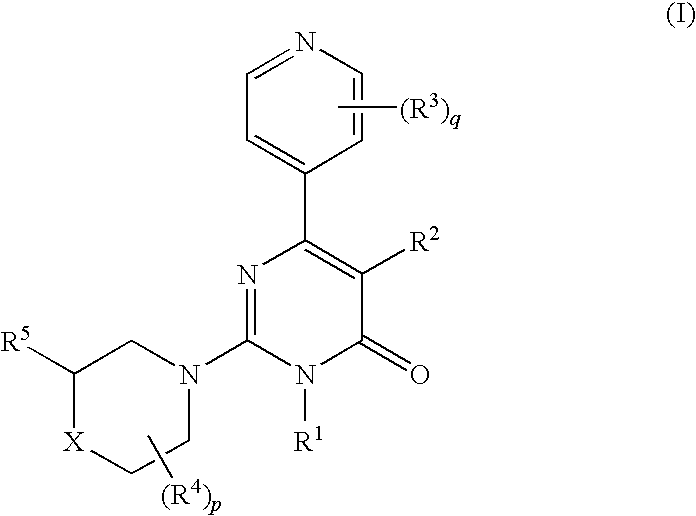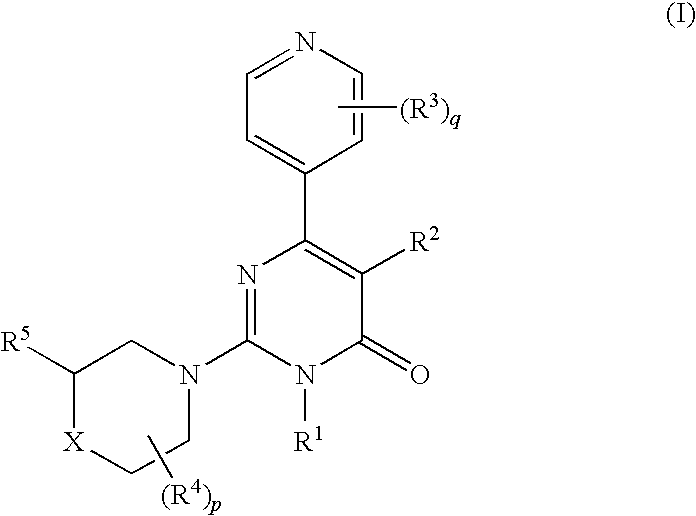6-(pyridinyl)-4-pyrimidone derivates as tau protein kinase 1 inhibitors
a technology of tau protein and pyrimidone, which is applied in the field of compounds, can solve the problems of unelucidated disease, increased patient numbers, and serious social problems of disease, and achieve the effect of suppressing the neurotoxicity of a and inhibiting the death of nerve cells
- Summary
- Abstract
- Description
- Claims
- Application Information
AI Technical Summary
Benefits of technology
Problems solved by technology
Method used
Image
Examples
reference example 1
Synthesis of 2-chloro-6-(3-fluoropyridin-4-yl)-3-methyl-3H-pyrimidin-4-one
3-Fluoroisonicotinic Acid
3-Fluoropyridine (25 g, 257 mmol) was added to a solution of butyllithium (270 mmol) and diisopropylamine (27.4 g, 271 mmol) in tetrahydrofuran (600 mL) at −78° C. After stirring for one hour, crushed dry ice was added to the solution and the solution was warmed to room temperature during one hour. Aqueous hydrogen chloride was added to the solution to acidify the solution to pH 5. The resulting precipitate was filtered and dried. The title compound (25.2 g, 179 mmol, 70%) was obtained as colorless crystal.
3-(3-Fluoro-pyridin-4-yl)-3-oxo-propionic Acid Ethyl Ester
Carbonyl diimidazole (30.5 g, 188 mmol) was added to a solution of 3-fluoroisonicotinic acid (25.2 g, 179 mmol) in tetrahydrofuran, and the mixture was refluxed for 1 hour. After cooled to room temperature, the solution was added with potassium monoethylmalonate (33.6 g, 197 mmol) and magnesium chloride (20.5 g, 215 mmol), and...
reference example 2
Synthesis of 2-Chloro-6-(2,3-dichloropyridin-4-yl)-3-methyl-3H-pyrimidin-4-one
2,3-Dichloroisonicotinic Acid
To a solution of diisopropylamine (21.6 g, 213 mmol) and n-butyllithium in hexane (137 ml, 214 mmol) in tetrahydrofuran (600 ml) was added 2,3-dichloropyridine (30.0 g, 203 mmol) in tetrahydrofuran at −78° C. After 2 hour stirring, dry ice (100 g) was added and the solution was further stirred for one hour. Resulting white precipitate formed by acidification to pH 1 with 6N hydrochloric acid was collected by filtration and dried to afford 2,3-dichloroisonicotinic acid (32.5 g, 169 mmol, 83%) as white crystals.
3-((2,3-Dichloropyridin)-4-yl)-3-oxo-propionic acid ethyl ester
A solution of 2,3-dichloroisonicotinic acid (25.3 g, 132 mmol) and 1,1′-carbonyldiimidazole (22.5 g, 139 mmol) in tetrahydrofuran (500 ml) was heated at 90° C. for 2 hours. Malonic acid monoethyl ester potassium salt (24.7 g, 145 mmol) and magnesium chloride (15.1 g, 159 mmol) was added and heated at 60° C. for...
reference example 3
Synthesis of (2S)-2-(4-Piperidin-1-yl-phenyl)-piperazine Trihydrochloride
(2S)-2-(4-Bromophenyl)-piperazine-1,4-dicarboxylic acid di-tert-butyl ester
(2S)-2-(4-Bromophenyl)-piperazine-1,4-dicarboxylic acid di-tert-butyl ester was prepared from 4-bromophenacyl bromide by the same route as (2S)-2-(4-chlorophenyl)-piperazine-1,4-dicarboxylic acid di-tert-butyl ester in WO2004 / 085408.
(2S)-2-(4-Piperidin-1-yl-phenyl)-piperazine-1,4-dicarboxylic acid di-tert-butyl ester
A solution of (2S)-2-(4-bromophenyl)-piperazine-1,4-dicarboxylic acid di-tert-butyl ester (1.06 g, 2.40 mmol), piperidine (0.29 ml, 2.88 mmol), palladium acetate (22.0 mg, 0.096 mmol), sodium tert-butoxide (323 mg, 3.36 mmol) and 2-(di-t-butylphosphino)biphenyl (57.0 mg, 0.192 mmol) in toluene (16 ml) was stirred at 80° C. for 6 hours. Water and ethyl acetate were added to the solution and the solution was passed through Celite column. The whole was extracted with ethyl acetate and the organic lawyer was washed with brine, dr...
PUM
| Property | Measurement | Unit |
|---|---|---|
| molecular weights | aaaaa | aaaaa |
| optically active | aaaaa | aaaaa |
| physicochemical properties | aaaaa | aaaaa |
Abstract
Description
Claims
Application Information
 Login to View More
Login to View More - R&D
- Intellectual Property
- Life Sciences
- Materials
- Tech Scout
- Unparalleled Data Quality
- Higher Quality Content
- 60% Fewer Hallucinations
Browse by: Latest US Patents, China's latest patents, Technical Efficacy Thesaurus, Application Domain, Technology Topic, Popular Technical Reports.
© 2025 PatSnap. All rights reserved.Legal|Privacy policy|Modern Slavery Act Transparency Statement|Sitemap|About US| Contact US: help@patsnap.com



